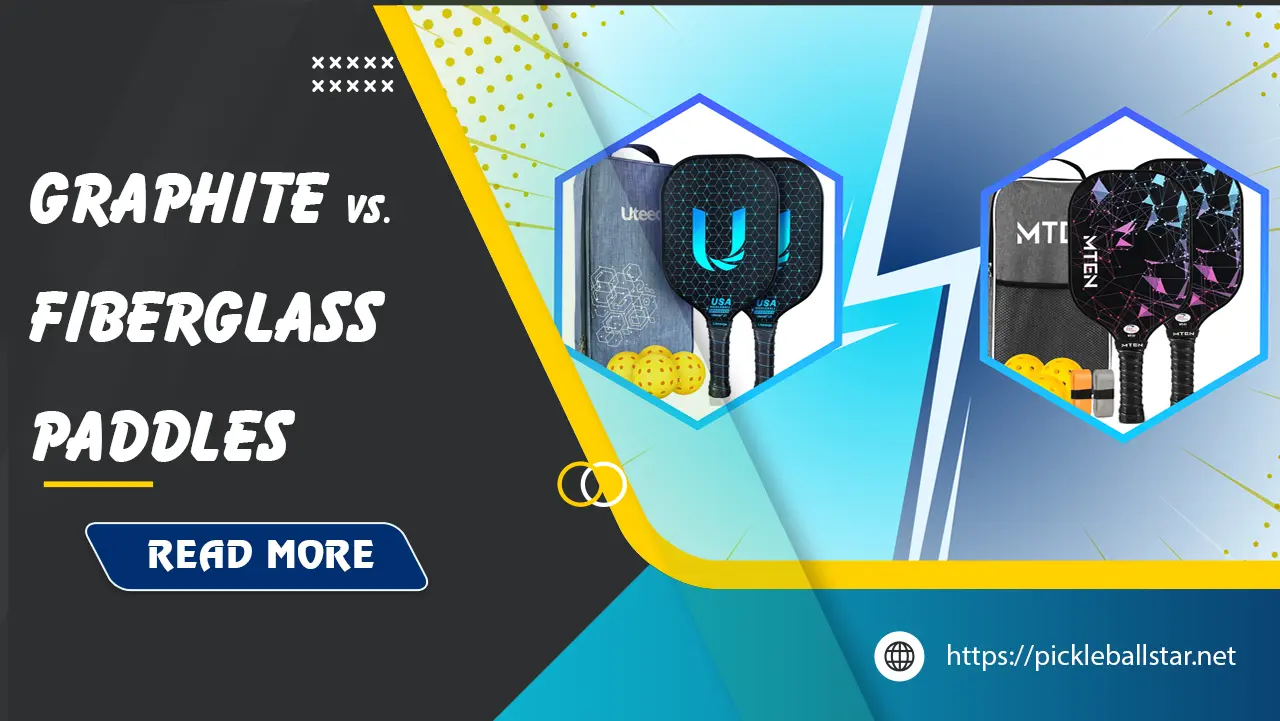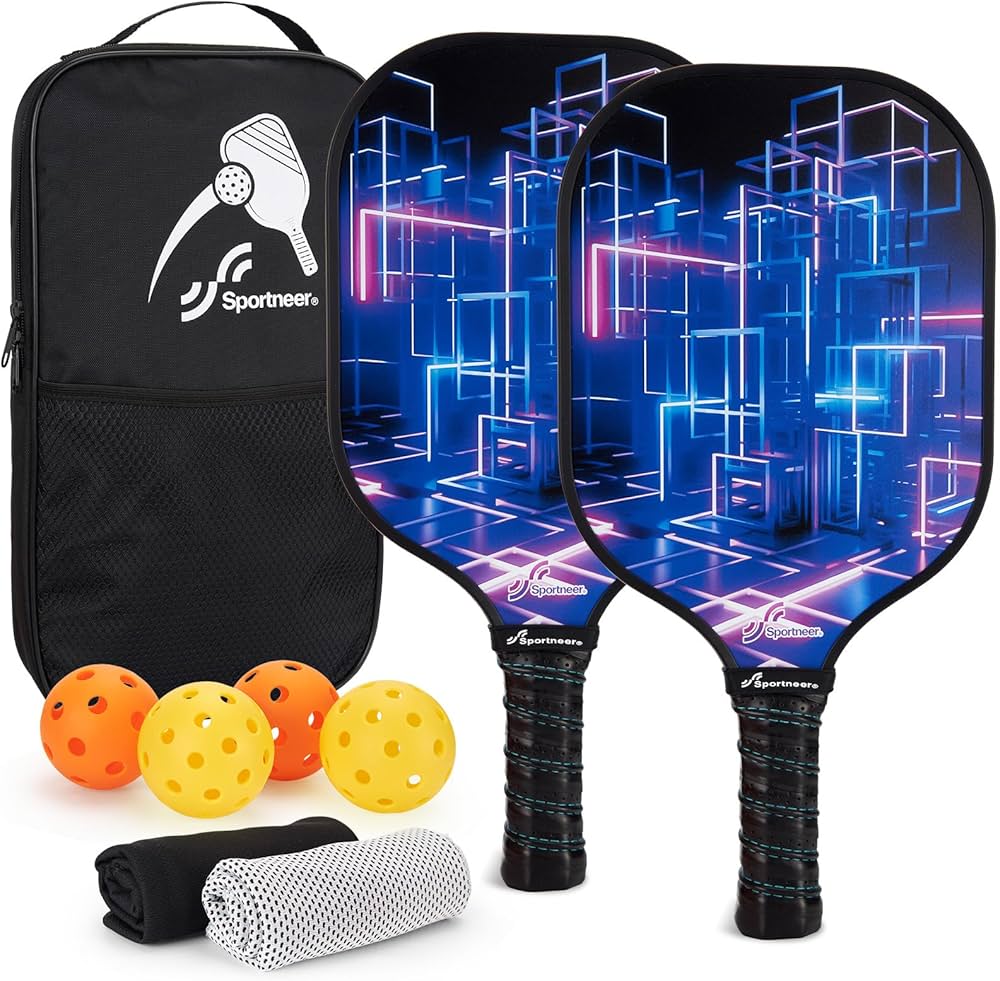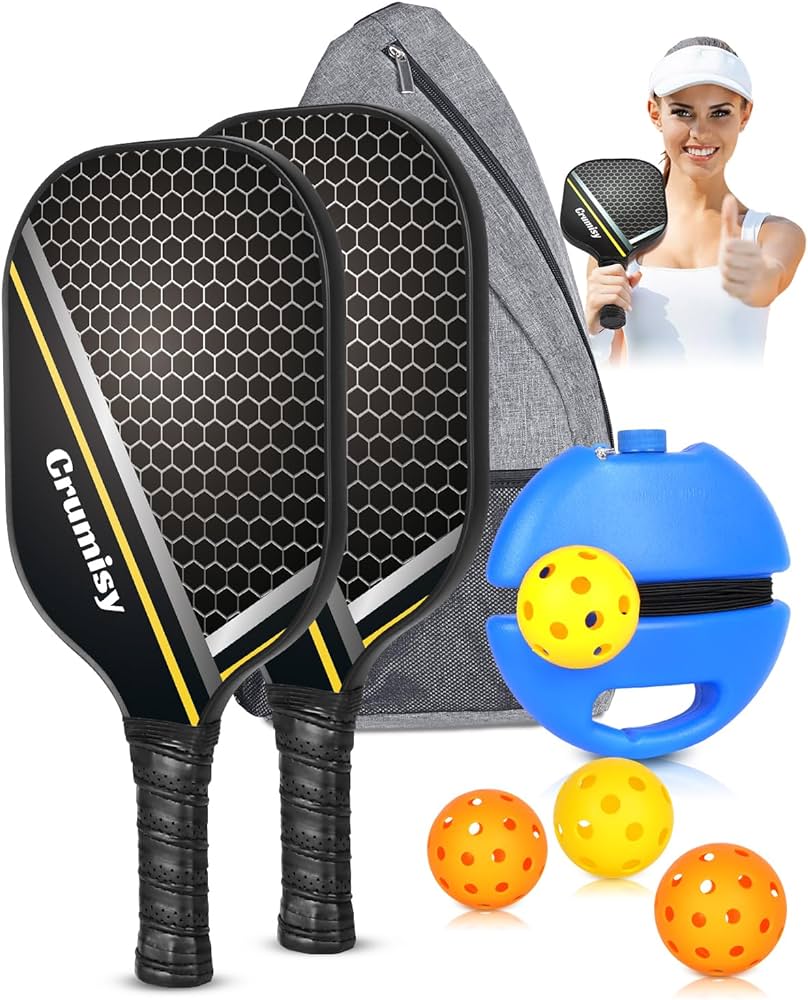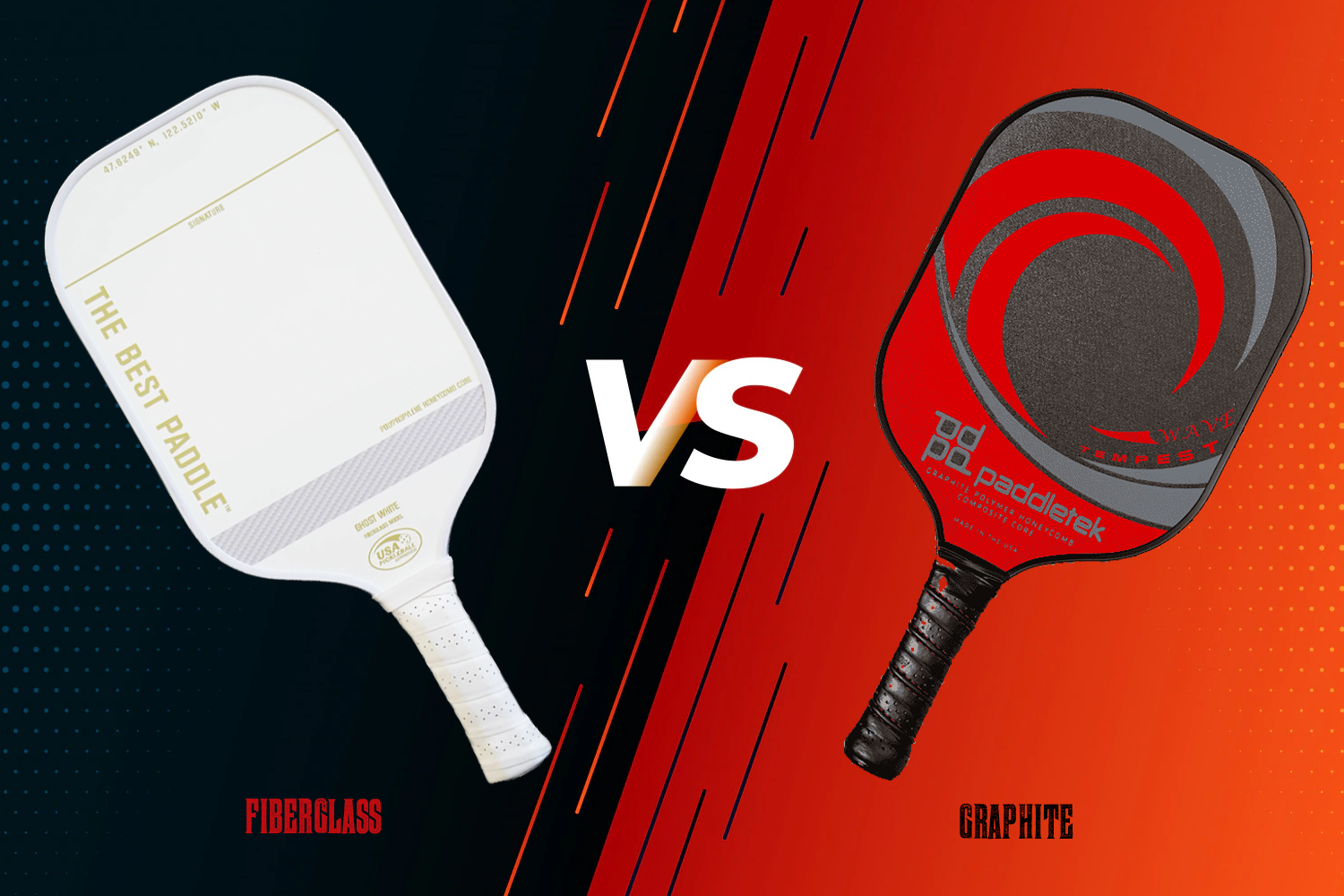Graphite vs Fiberglass Pickleball Paddles: A Showdown of Materials
Pickleball paddle materials play a crucial role in influencing a player’s game, and graphite and fiberglass paddles are two popular choices with distinct characteristics. Understanding the advantages and disadvantages of graphite vs fiberglass pickleball paddles can help you make an informed decision about which one is best suited for your playing style and preferences. While fiberglass has long been a popular choice for pickleball paddles due to its durability and affordability, graphite paddles have gained popularity for their enhanced performance and responsiveness. By carefully considering the nuances of each material, you can select the paddle that best complements your game and helps you unlock your full potential.

Fiberglass Pickleball Paddles: The Classic and Affordable Choice

Durability and Affordability: A Reliable and Budget-Friendly Option
Fiberglass paddles are often celebrated for their durability and affordability, making them a reliable choice for players of all levels. Constructed primarily with a fiberglass face, these paddles are designed to offer a good blend of strength and flexibility. This creates a perfect balance that withstands wear and tear while providing a comfortable playing experience. The construction method makes fiberglass paddles accessible for beginners who are just getting into the sport without breaking the bank.
The budget-friendly nature of fiberglass paddles allows amateur players to invest in quality gear without the fear of making a significant financial commitment. In the world of sports equipment, where high price tags often equate to better performance, fiberglass offers an excellent middle-ground option for those seeking durability without overspending. Players can purchase these paddles with confidence, knowing they will last through numerous games and practice sessions, offering a consistent playing experience over the long haul.
A Consistent Feel and Response: Ideal for Beginners and Casual Players
One of the significant appeals of fiberglass paddles lies in their ability to provide a consistent feel and response. While they might not offer the same power levels as the more expensive graphite paddles, they make up for it with predictable performance. This aspect is crucial, especially for beginners who are still learning the ropes of the game.
The flexibility of fiberglass helps absorb shock from the ball’s impact, reducing vibrations felt on the player’s hand. This absorption not only makes each shot feel smoother but also minimizes fatigue over extended play sessions. As you learn how to control the paddle and place your shots accurately, this predictable response can serve as a confidence booster. You’re less likely to encounter surprises or mishits, allowing you to focus more on improving your technique rather than adjusting to your paddle.
Moreover, fiberglass paddles generally feature a larger sweet spot compared to graphite paddles. This increases the probability of solid contact, making it easier to land accurate shots. For casual players who might not spend hours practicing every week, this larger sweet spot can be quite forgiving, helping maintain a decent level of play without the need for perfect precision.
Graphite Pickleball Paddles: Unleashing Power and Precision
Lightweight and Responsive: A Paddle for Speed and Control

Graphite paddles have surged in popularity among pickleball enthusiasts for good reasons. Known for being incredibly lightweight, these paddles are constructed with a graphite face, often combined with high-quality core materials like Nomex or polymer cores. This combination results in a paddle that enables players to move swiftly and react quickly to fast volleys and smashes.
The lightweight nature of graphite paddles allows for greater maneuverability, making it easier to control the tempo of the game. When you need to perform a quick defensive block or switch from a backhand to a forehand shot, the reduced weight means you can achieve these moves with less effort. This enhanced control is particularly beneficial for advanced players who need to precisely place their shots and outmaneuver their opponents with finesse.
Furthermore, the responsiveness of graphite paddles enhances a player’s connection with the ball. Each shot feels more tactile, giving players a better sense of control and feedback. This tactile feedback can be likened to a well-tuned musical instrument, where each note resonates with perfection, allowing the player to compose a symphony of well-placed shots and strategic plays.
Enhanced Power and Performance: Taking Your Game to the Next Level
One of the standout features of graphite paddles is their ability to generate enhanced power. The stiffness of graphite material allows for more force to be transferred from the paddle to the ball. This results in faster shots, enabling more aggressive playstyles that can keep opponents on the back foot. If you’re a player who thrives on powerful smashes and rapid exchanges, a graphite paddle can be a game-changer, providing that extra oomph required to outpace your competition.
Graphite paddles not only offer power but also a level of precision that can elevate your game to new heights. The smooth, responsive feel helps players execute a broader range of shots with greater accuracy. Whether it’s a dink shot close to the net or a deep, powerful drive, the precision offered by graphite paddles can help fine-tune your performance.
Professional players and those competing at higher levels often lean towards graphite paddles for their combination of power, precision, and lightweight design. This convergence of attributes allows for a versatile gameplay style, where you can switch between defensive and offensive strategies seamlessly, adapting to the ever-changing dynamics of a match.
Choosing the Right Paddle for You: Key Considerations

Playing Style: Matching Paddle Material to Your Game
Choosing the right pickleball paddle involves aligning your playing style with the paddle’s characteristics. For players with an aggressive playstyle who prioritize power and speed, a graphite paddle might be the best fit. The increased power and responsiveness of graphite paddles make them ideal for executing fast-paced rallies and powerful smashes. Players who favor control and precision in their shots will also benefit from the tactile feedback and quicker reaction time that graphite paddles offer.
On the other hand, if you prefer a more consistent and forgiving playing experience, a fiberglass paddle could be your go-to choice. The flexibility and shock absorption of fiberglass paddles make them more comfortable to use, especially for extended play sessions. Casual players and those who are still developing their skills might find the larger sweet spot and consistent response of fiberglass paddles to be more advantageous. This allows you to enjoy the game without the pressure of achieving perfect precision on every shot.
Skill Level and Experience: Considering Material for Different Players
Your skill level and experience can significantly influence your decision when choosing between graphite and fiberglass paddles. Beginners and intermediate players might lean towards fiberglass paddles due to their affordability and forgiving nature. The durability and larger sweet spot offer a more user-friendly experience, making it easier to learn and improve. For players who are still mastering the fundamentals of pickleball, the consistency provided by fiberglass paddles can be a valuable asset.
As you gain experience and develop your skills, you might find yourself drawn to the performance enhancements offered by graphite paddles. Advanced players who seek to refine their technique and take their game to the next level will appreciate the power and precision provided by graphite paddles. The lightweight design and enhanced responsiveness can help you fine-tune your shots and execute more advanced strategies.
Budget and Investment: Balancing Performance and Cost
Budget considerations are crucial when selecting your pickleball paddle. Fiberglass paddles are generally more affordable than their graphite counterparts, making them an attractive option for players who are conscious of their spending. Beginners and those who play casually might find fiberglass paddles to be a cost-effective solution that doesn’t compromise on quality. Investing in a durable and reliable fiberglass paddle allows you to enjoy the game without straining your budget.
For players who are willing to invest more for enhanced performance, graphite paddles offer a higher price range. The advanced features, lightweight construction, and superior responsiveness justify the higher cost for those who are serious about their game. If you’re an experienced player committed to improving your skills and achieving peak performance, a graphite paddle can be a valuable investment that pays off in terms of power, precision, and overall gameplay.
Common Questions
Is Graphite Always the Best Material for a Pickleball Paddle?
Graphite is not always the best material for everyone. While it offers exceptional power and responsiveness, it may not be suitable for beginners or players with a more casual playing style. The choice between graphite and fiberglass ultimately depends on individual preferences, playing style, and skill level.
What Are Some of the Key Differences Between Composite and Carbon Fiber Paddle Construction?
Composite paddles, often made from materials like fiberglass, offer excellent durability and affordability. Carbon fiber paddles, including graphite, provide enhanced performance, lightweight design, and increased power. The differences lie in the materials used, resulting in variations in durability, cost, and responsiveness.
What Are Some Popular Pickleball Paddle Brands That Offer Both Composite and Carbon Fiber Options?
Several reputable brands offer a variety of pickleball paddles to cater to different player preferences. Some popular brands that offer both composite and carbon fiber options include:
- Selkirk Sport: Known for their high-quality paddles, Selkirk offers both fiberglass and graphite options.
- Paddletek: Another top brand that provides a range of paddles made from different materials to suit various playing styles.
- ONIX: Offers paddles with various core materials, including fiberglass and graphite, catering to players of all levels.
How Do Composite and Graphite Paddles Compare in Terms of Price, Durability, and Performance?
Composite paddles, such as those made with fiberglass, are generally more affordable and durable, making them a popular choice for beginners. Graphite paddles, while more expensive, offer enhanced performance, increased power, and a lightweight design that appeals to advanced players. The choice depends on balancing performance needs and budget considerations.
Conclusion
In conclusion, fiberglass and graphite pickleball paddles offer distinct advantages and cater to different playing styles and preferences. Fiberglass paddles provide durability, affordability, and a consistent feel, making them ideal for beginners and casual players. On the other hand, graphite paddles offer lightweight construction, enhanced power, and unmatched responsiveness, making them a preferred choice for advanced players looking to elevate their game.
Choosing the right paddle involves considering your playing style, skill level, and budget. The best pickleball paddle for you will depend on your individual needs and preferences. By carefully evaluating the characteristics of each material, you can make an informed decision that enhances your performance and enjoyment on the pickleball court.
Explore the world of fiberglass and graphite paddles to find the one that unlocks your full potential. Test both materials, and discover the paddle that aligns with your playing style and helps you achieve your pickleball goals. Happy playing!
